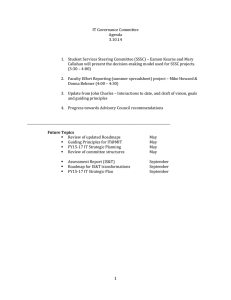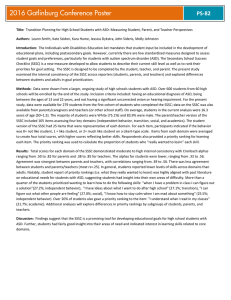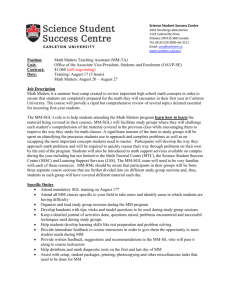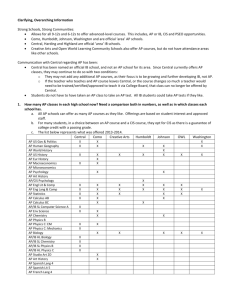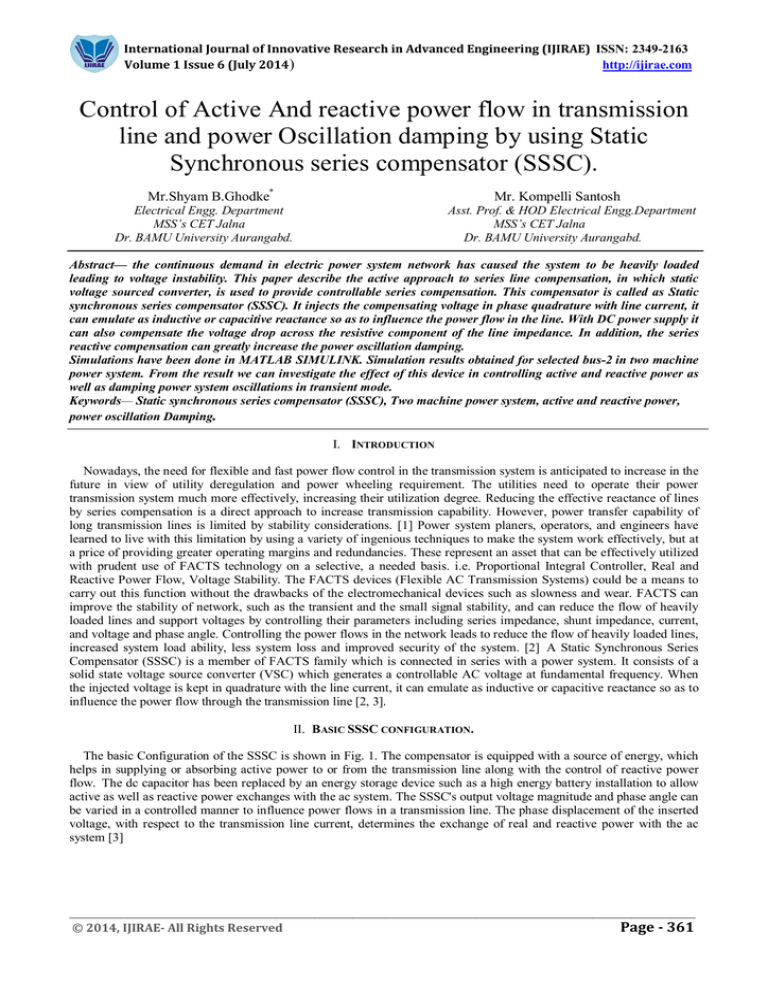
International Journal of Innovative Research in Advanced Engineering (IJIRAE) ISSN: 2349-2163
Volume 1 Issue 6 (July 2014)
http://ijirae.com
Control of Active And reactive power flow in transmission
line and power Oscillation damping by using Static
Synchronous series compensator (SSSC).
Mr.Shyam B.Ghodke*
Mr. Kompelli Santosh
Electrical Engg. Department
MSS’s CET Jalna
Dr. BAMU University Aurangabd.
Asst. Prof. & HOD Electrical Engg.Department
MSS’s CET Jalna
Dr. BAMU University Aurangabd.
Abstract— the continuous demand in electric power system network has caused the system to be heavily loaded
leading to voltage instability. This paper describe the active approach to series line compensation, in which static
voltage sourced converter, is used to provide controllable series compensation. This compensator is called as Static
synchronous series compensator (SSSC). It injects the compensating voltage in phase quadrature with line current, it
can emulate as inductive or capacitive reactance so as to influence the power flow in the line. With DC power supply it
can also compensate the voltage drop across the resistive component of the line impedance. In addition, the series
reactive compensation can greatly increase the power oscillation damping.
Simulations have been done in MATLAB SIMULINK. Simulation results obtained for selected bus-2 in two machine
power system. From the result we can investigate the effect of this device in controlling active and reactive power as
well as damping power system oscillations in transient mode.
Keywords— Static synchronous series compensator (SSSC), Two machine power system, active and reactive power,
power oscillation Damping.
I. INTRODUCTION
Nowadays, the need for flexible and fast power flow control in the transmission system is anticipated to increase in the
future in view of utility deregulation and power wheeling requirement. The utilities need to operate their power
transmission system much more effectively, increasing their utilization degree. Reducing the effective reactance of lines
by series compensation is a direct approach to increase transmission capability. However, power transfer capability of
long transmission lines is limited by stability considerations. [1] Power system planers, operators, and engineers have
learned to live with this limitation by using a variety of ingenious techniques to make the system work effectively, but at
a price of providing greater operating margins and redundancies. These represent an asset that can be effectively utilized
with prudent use of FACTS technology on a selective, a needed basis. i.e. Proportional Integral Controller, Real and
Reactive Power Flow, Voltage Stability. The FACTS devices (Flexible AC Transmission Systems) could be a means to
carry out this function without the drawbacks of the electromechanical devices such as slowness and wear. FACTS can
improve the stability of network, such as the transient and the small signal stability, and can reduce the flow of heavily
loaded lines and support voltages by controlling their parameters including series impedance, shunt impedance, current,
and voltage and phase angle. Controlling the power flows in the network leads to reduce the flow of heavily loaded lines,
increased system load ability, less system loss and improved security of the system. [2] A Static Synchronous Series
Compensator (SSSC) is a member of FACTS family which is connected in series with a power system. It consists of a
solid state voltage source converter (VSC) which generates a controllable AC voltage at fundamental frequency. When
the injected voltage is kept in quadrature with the line current, it can emulate as inductive or capacitive reactance so as to
influence the power flow through the transmission line [2, 3].
II. BASIC SSSC CONFIGURATION.
The basic Configuration of the SSSC is shown in Fig. 1. The compensator is equipped with a source of energy, which
helps in supplying or absorbing active power to or from the transmission line along with the control of reactive power
flow. The dc capacitor has been replaced by an energy storage device such as a high energy battery installation to allow
active as well as reactive power exchanges with the ac system. The SSSC's output voltage magnitude and phase angle can
be varied in a controlled manner to influence power flows in a transmission line. The phase displacement of the inserted
voltage, with respect to the transmission line current, determines the exchange of real and reactive power with the ac
system [3]
_________________________________________________________________________________________________
© 2014, IJIRAE- All Rights Reserved
Page - 361
International Journal of Innovative Research in Advanced Engineering (IJIRAE) ISSN: 2349-2163
Volume 1 Issue 6 (July 2014)
http://ijirae.com
Fig.1 Static synchronous series compensator.
III. CONTROL SCHEME OF SSSC
SSSC is similar to the variable reactance because the injected voltage and current to the circuit by this device are
changing depend upon to the system conditions and the loads entering/getting out. For responding to the dynamic and
transient changes created in system, SSSC utilizes the series converter. One side of the converter is connected to the AC
system and the other side is connected to a capacitor and battery which in the system we assume DC source as battery. If
a dynamic change in system will be occurred, the energy of battery will be converted to the ac form by converter and
then injecting this voltage to the circuit the changes will be damped appropriately. To control the active and reactive
powers of bus-2, the control circuit as shown in Fig. 2 is utilized. For controlling the powers, first, sampling from the
voltage and current is done and transformed to the dq0 values. Active and reactive powers of bus-2 are calculated using
their voltage and current in dq0 references and compared with the determined reference and the produced error signal is
given to the PI controllers. Adjusting parameters of the PI controllers, we are trying to achieve the zero signal error, such
that powers can follow the reference powers precisely. Then, the output of the controllers are transformed to the abc
reference and given to the PWM.
Fig .2 Control Scheme for SSSC.
IV. TWO MACHINE POWER YSTEM MODEL.
The system shown in fig.3 is simulated in MATLAB SIMULINK, to analyze the dynamic performance of SSSC in
real time current and voltage waveforms. Which has been made in ring mode consisting of 4 buses (B1 to B4) connected
to each other through three phase transmission lines L1, L2-1, L2-2 and L3 with the length of 280, 150, 150 and 50 km
respectively. System has been supplied by two power plants with the phase-to-phase voltage equal to 13.8 kv Active and
reactive powers injected by power plants 1 and 2 to the power system are presented in per unit by using base parameters
Sb=100MVA and Vb=500KV, which active and reactive powers of power plants 1 and 2 are (24-j3.8) and (15.6-j0.5) in
per unit, respectively.
_________________________________________________________________________________________________
© 2014, IJIRAE- All Rights Reserved
Page -362
International Journal of Innovative Research in Advanced Engineering (IJIRAE) ISSN: 2349-2163
Volume 1 Issue 6 (July 2014)
http://ijirae.com
Fig.3 Single line diagram for tow machine system with SSSC.
V. SIMULATION RESULTS IN MATLAB SIMULINK
The power system with two machines and four buses has been simulated in MATLAB environment, and then active and
reactive powers and voltages in all buses have been obtained. The bus 2 is at the middle of the transmission line so that it
was selected as candidate bus to connect the SSSC Therefore, the simulation results have been focused on bus-2.
A. Bus -2 Parameter s without SSSC
Changes in current, voltage, active and reactive powers of bus-2 have been obtained in real time. The Figure. 4 shows
the simulink model without SSSC .at first, due to the large loads of the system active power of bus-2 got oscillations
which keep continuing for 3 seconds.
A
B
Discrete,
Ts = 5e-005 s.
pow ergui
Bus 1
Bus 2
A
aA
B
bB
cC
A
B
C
C
L2-1
(150 km)
1400 MVA
13.8 kV/500 kV
B4
B3
Aa
Aa
A
Bb
Bb
B
Cc
Cc
L2-2
(150 km)
C
L3_50km
A
B
C
250 MW
Three-Phase
Dynamic Load
Bus 4
Bus 3
B1
2100 MVA
500 kV
m
C
A
B
C
100 MW
50 MW
B2
aA
bB
cC
L1
(280 km)
Fig.4 Simulink model of two machine system without SSS.
According to fig 5 and fig. 6 active and reactive power of bus -2 got oscillations and then damped properly by
controlling systems in plants 1 and 2 such as governor, PSS and other stabilizing devices.
_________________________________________________________________________________________________
© 2014, IJIRAE- All Rights Reserved
Page -363
International Journal of Innovative Research in Advanced Engineering (IJIRAE) ISSN: 2349-2163
Volume 1 Issue 6 (July 2014)
http://ijirae.com
Fig. 5 Active power of bus-2 without SSSC
Fig. 6 Reactive power of bus-2 without SSSC
Fig.7 Phase current of bus-2 without SSSC.
Fig. 8 Voltage of bus-2 without SSSC.
_________________________________________________________________________________________________
© 2014, IJIRAE- All Rights Reserved
Page -364
International Journal of Innovative Research in Advanced Engineering (IJIRAE) ISSN: 2349-2163
Volume 1 Issue 6 (July 2014)
http://ijirae.com
B. Bus-2 Parameters with SSSC
As shown in Figure. 9, SSSC has been placed between bus-1 and bus-2 and the aim is achieving the following active
and reactive powers:
Pref = 4 pu
Qref.= -1 pu
Discr ete,
Ts = 5e-005 s.
pow er gui
A
B
Bus 1
Bus 3
Bus 2
B1
A
aA
B
bB
cC
B4
B3
Aa
Aa
Bb
Bb
Cc
Cc
Three-Phase
Dynam ic Load
Three-Phase Source
A
B
C
L3_50km
C
A
250 MW
L2-2
(150 km)
B
L2-1
(150 km )
C
B
Three-Phase Source1
A
C
m
C
Bus 4
C
B
A
100 MW
50 M W
B2
aA
bB
cC
c3
b3
a3
a2
b2
c2
L1
(280 km)
B
Y
R
A
B
C
Three-Phase
Transform er
(Thr ee Windings)
SSSC
Fig. 9 Simulink model of two machine system with SSSC
The main role of SSSC is controlling the active and reactive powers; beside these SSSC could fairly improve the
transient oscillations of system. After the installation of SSSC, besides controlling the power flow in bus-2 we want to
keep constant the voltage value in 1 per unit, hence the power flow is done in the presence of SSSC and the simulation
results are as follows.
Fig. 10 Active power of bus-2 without SSSC
Fig. 11 Reactive power of bus-2 without SSSC
_________________________________________________________________________________________________
© 2014, IJIRAE- All Rights Reserved
Page -365
International Journal of Innovative Research in Advanced Engineering (IJIRAE) ISSN: 2349-2163
Volume 1 Issue 6 (July 2014)
http://ijirae.com
Fig. 12 Current of bus-2 with SSSC
VI. Conclusion
From the simulation result it is clear that SSSC is capable of controlling active and reactive power flow in the power
system at desired point. From the simulation results the performance of SSSC has been examined in simple two machine
system, and applications of SSSC can be extended to complex and multi machine system.
REFERENCES
[1] M. Faridi, H. Maeiiat, M. Karimi, P. Farhadi and H. Moslesh (2011) Power System Stability Enhancement Using
Static Synchronous Series Compensator (SSSC)” IEEE Transactions on Power System, pp. 387-391.
[2] Gyugyi, L. (1989). “Solid-state control of AC power transmission.” International Symposium on Electric Energy
Conversion in Power System, Capri, Italy, (paper No. T-IP.4).
[3] B. Suresh Kumar, “Enhancement of Voltage Stability using Static Synchronous Series Compensator (SSSC) with PI
Controller-LLLG Fault”, International Journal of Advanced Research in Engineering & Technology (IJARET),
Volume 4, Issue 5, 2013, pp. 164 - 175, ISSN Print: 0976-6480, ISSN Online: 0976-6499.
[4] N. G. Hingorani, L. Gyugyi, “Understanding FACTS: Concepts and Technology of Flexible AC Transmission
Systems”, New York: IEEE Press, 2000.
[5] Gyugi L. (1997) static synchronous series compensator: A solid-state approach to the series compensation of the
line. IEEE Transaction on power delivery, Vol. 12 No. 1 January 1997.
_________________________________________________________________________________________________
© 2014, IJIRAE- All Rights Reserved
Page -366

